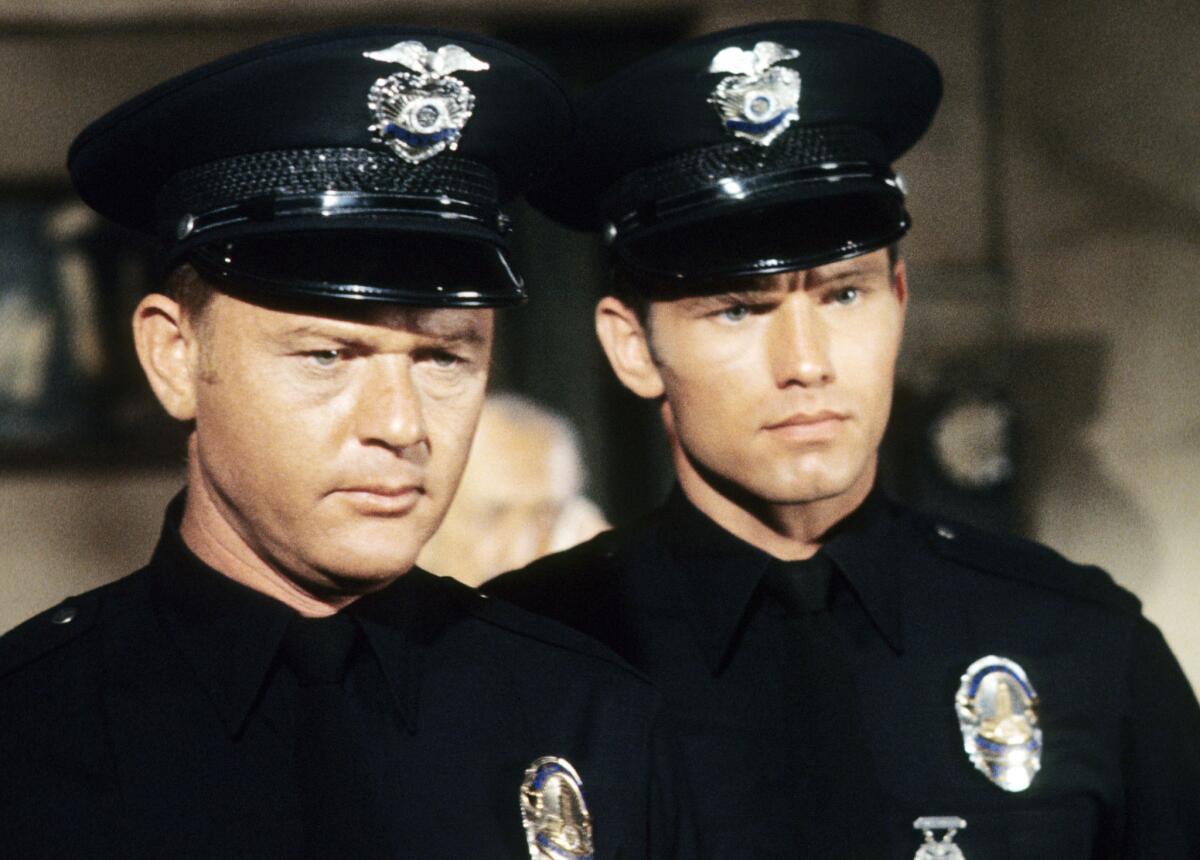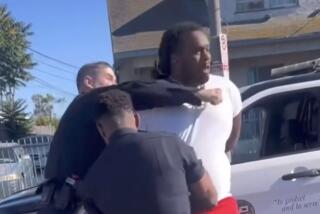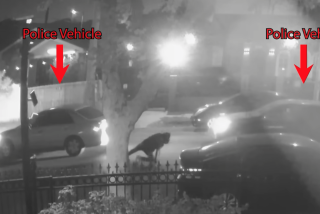He played a kind cop on TV -- and inspired a generation of LAPD

Martin Milner, left, as Officer Pete Malloy and Kent McCord as Officer Jim Reed in “Adam-12.”
1-Adam-12, 1-Adam-12.”
For many in the LAPD, that was the siren call.
As kids, they sprawled on their living room carpets, watched “Adam-12” on TV and made up their minds to one day join the force, just like Officers Pete Malloy and Jim Reed.
Malloy’s real name was Martin Milner. He died last month at 83. At the Los Angeles Police Department, however, the officer he played remains very much alive.
Forty years after the show went off the air, in fact, Malloy still is so loved that dozens of uniformed officers gathered Wednesday to remember him.
They filled the seats of the police headquarters auditorium for a tribute to Milner — and Malloy — that included an honor guard, bagpipers from the Los Angeles Police Emerald Society guard, a nostalgic video homage and a passionate speech by Chief Charlie Beck.
When Beck spoke, it was as if he were delivering a private pep talk to his troops.
“It isn’t easy being a cop in L.A.,” he told them, an unspoken reference to growing distrust and criticism of police.
“Adam-12,” which ran from 1968 to 1975, made the real LAPD better both during those years and after, Beck said. Real officers emulated the TV officers.
“As you watch any of the ‘Adam-12’ episodes, you see professional, compassionate, internally driven, hardworking, clean-cut, impeccably tailored, fit Los Angeles police officers — those police officers that have no dark side, that do the right things for the right reasons every time.
“And that is the image that drew us all to this place.”
Sharing the front row with Beck for the more than hourlong ceremony were Milner’s widow, Judy, as well as his three surviving children: Molly, Stuart and Andrew. Sitting with them was Kent McCord, 73, who played rookie Officer Jim Reed, Malloy’s partner on the show.
McCord choked up several times when he spoke, not least when he told the gathered force: “We love you all. We were very proud of what we did.”
He noted that the show debuted during a period of great tension. “It’s almost come full circle in my eyes,” he said.
The first episode aired three years after the Watts riots and a month after protesters faced down police and the National Guard at the Democratic Convention in Chicago as the Vietnam War continued to rage.
“Police officers were at the front line of the establishment at that time. And in steps this show that puts you inside the car and shows you inside two police officers in uniform,” McCord said.
The show was one of the first filmed largely on location, and summertime shooting attracted “huge crowds of kids,” he said.
Officers often stopped by too. One once told them he’d seen a big, positive difference in the way young people reacted to police since “Adam-12” went on the air.
Malloy and Reed were always courteous, always working in the people’s best interests, always trying to protect them from harm. One minute they might be explaining to a teenage dirt biker how a single spark on a trail could set the dry hills ablaze. The next, they might arrive at a front door to gently break the news that a loved one had died.
Police were there to help, the show said. They toiled tirelessly in service of citizens. Good people had no reason to fear them.
Speaker after speaker mentioned the care the show took to portray police life accurately, down to the equipment and the codes used.
Glynn Martin, executive director of the Los Angeles Police Museum, said he’d learned the Miranda warning by heart watching the show, and delivered it to his childhood dog.
After the speeches were over, Beck acknowledged that his was meant to buck up his officers.
“I think it’s a difficult time for policing, and a good time for people to recognize how tough a job it is — how hard it is to do it perfectly but how diligently men and women try. Do they come up short? Sometimes, yeah, just like everybody does,” he said. “But it isn’t because they don’t have true hearts and noble purpose.”
A few feet away, a crowd had gathered around McCord. One detective in jacket and tie wanted him to sign a photograph. Another asked if he’d pose for a photo with her. The cops were middle-aged. But as they caught McCord’s eye, there was something of the awed child in their glances.
Outside the auditorium, officers lingered. Some looked at the various displays that had been brought in for the occasion.
The Vintage L.A. Coppers, a nonprofit volunteer group that tries to preserve the history of the department from 1940 into the early 1970s, had placed a gleaming police car and station wagon from the “Adam-12” era in the courtyard outside the lobby doors.
On a table, they had assembled an array of memorabilia — an “Adam-12” lunchbox, “Adam-12” View-Master slides, the two TV officers on the cover of a very old copy of “TV Guide.”
The time warp continued into the lobby, where a living room had been set up: shag carpet, folding tray tables, a phonograph, a standing ashtray, a mustard couch and armchair, Coca-Cola bottles.
In center position was a console TV, playing one “Adam-12” episode after another.
Follow City Beat on Twitter and Facebook. Read moreCity Beats here.
Email ideas for future City Beats to nita.lelyveld@latimes.com
More to Read
Sign up for Essential California
The most important California stories and recommendations in your inbox every morning.
You may occasionally receive promotional content from the Los Angeles Times.











